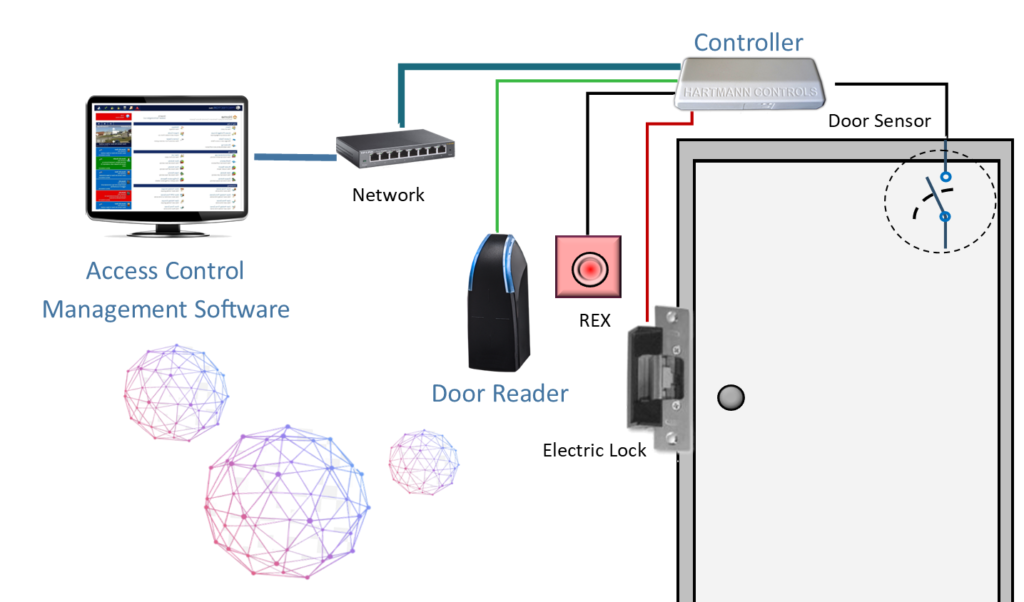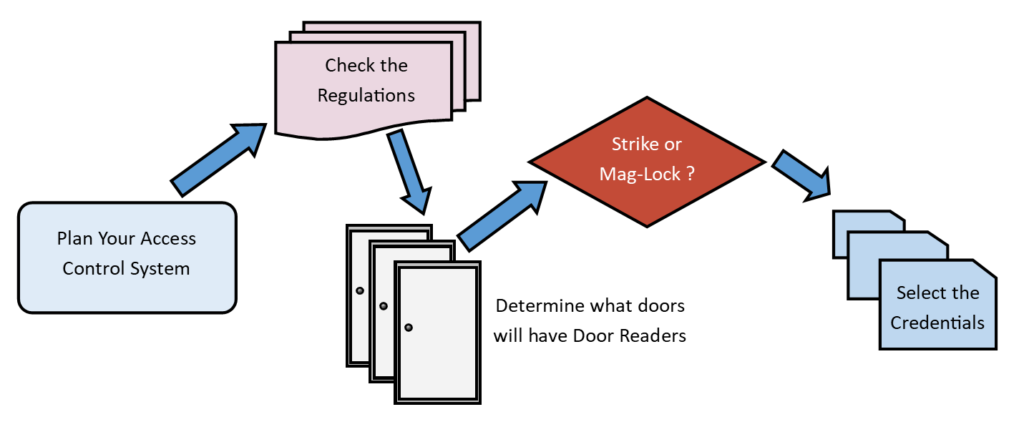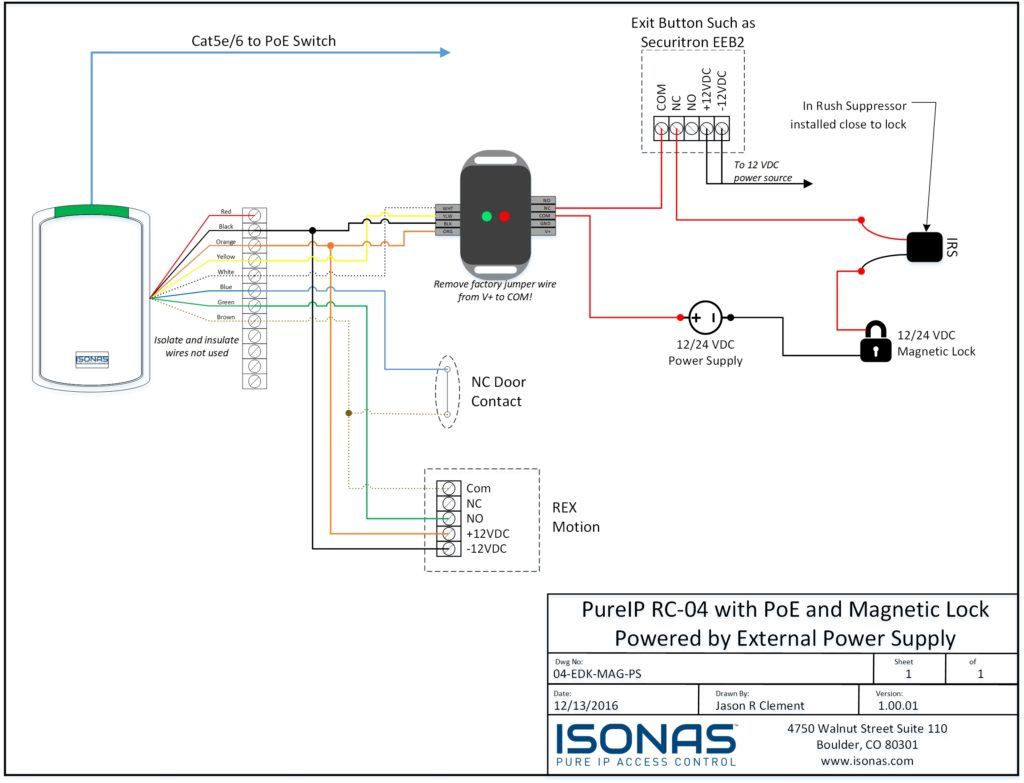A Guide to Door Access Control Installation

Installing door access control requires mechanical lock installation, wiring, door reader mounting, and management software. You will find access control systems easy to install if you have installed other network-attached devices such as computers, IP cameras, or paging systems. One nice thing about the new access control systems is that you can install one door at a time. So, if you have a 16-door system, start with the first door. The rest will be simple.
This article reviews how to install a door access control system. If you are concerned about your first installation, contact Kintronics for assistance.
Getting Started with Access Control
Before you even purchase your access control system, there are some initial things to do.
- Determine the regulations that affect your installation
- Determine what doors will have Door Readers
- Check the door to determine what type of electric lock you will need.
- Determine what power you need to control the access control system and electric door lock
- Determine where and how you will access the network
- Determine what credentials you would like to use
- Determine everything you would like the access control system to do. This will define the type of management software you should use.

Regulations for Compliance
There are several regulations to consider before installing your system. For example, there are fire codes and regulations from the Americans with Disabilities Act. Other things to consider are HIPAA and OSHA standards for physical security. The codes can be different for each locality.
In general, fire codes require that the door control system provide an easy exit when an emergency such as a fire occurs. This is especially concerning when Electromagnetic door locks are used. The mag-lock holds the door closed in both entry and exit directions. They require additional exit devices to ensure safety. Push bars, motion detectors, and Request-to-Exit (REX) buttons are some of the things used to provide egress from a room with a mag-lock.
The electric strike is sometimes easier to use because the person can turn the doorknob to exit.
Codes to consider include IBC (International Building Codes). NFPA 72: Fire Alarms, NFPA 101 (Life Safety code), and NFPA 72 (Fire Alarm Code). Check with your local fire department or building codes to determine the regulations in your area.
Electric Locks for the Doors
Some doors are best suited for electric strikes, while others may require electromagnetic locks. Electric strikes require fewer exit controls than the magnetic lock because the mag-lock holds the door closed in both directions.
Electric strikes come in different sizes, so they fit particular size doors. It is essential to check with the manufacturer to ensure that a specific lock fits your door. To determine the right electric lock, you can refer to the lock dimensions and compare them to your door, but the easiest way is to send us a picture of the door frame and the door side of each door. We’ll check with the manufacturer to ensure fit. It is helpful to determine what power is required for each electric lock since that can determine the power supply needed. Read our article Door Readers for Everyone to learn more about the different door readers available.
When installing an electric strike, it’s essential to align the lock to the strike on the door jamb.
Power for the Electric Lock
Usually, electric locks require 12 VDC or 24 VDC, but it could be different. Power for the lock is sometimes available from the door controller but, in some situations, must be provided from a separate supply.
When a mag-lock is used, fire codes sometimes require that power be cut if a fire alarm is detected. Check the regulations before wiring the power. See the article Access Control and Fire Alarm System Integration to learn more
Credentials for Access Control Systems
Door access control systems use various credentials to unlock the door. Credentials can include physical cards we carry, a PIN we enter, a mobile credential in our smartphone, or even the physical aspect of a person (biometrics such as fingerprint or facial recognition).
It is essential to determine the type of credential you want to use because it determines the kind of door reader you use. Some credentials are easier to use, and others are more secure. Please read our article Comparison of Door Access Credentials to learn more about credentials.
Access Control Management Software
Door access management software is an essential part of your access control system. It operates with the door controller to manage the door readers in your organization. It allows you to enter and define all the people who will use the doors.
Most of the access management software available provides simple door reader management. You can control who, when, and where people can enter. What else do you need? It depends on your requirements.
Additional features will allow you to determine who is in the building, manage the system using your mobile device, lock down the building in an emergency, integrate with IP camera systems and visitor management systems, and many other features. To learn more about access control management software, please read How Access Control Management Software Works.
Installing the Access Control System
Once you have the door access control system, here are the steps for installing your door access control system.

- Run the wires
- Measure, align the lock and strike, and Install the electric door locks
- Install the door reader
- Wire the door lock to the door reader
- Wire the door reader to the controller or the network if it is a reader-controller
- Install the access control management software
- Test the credentials with one door.
- Determine who can manage the system and their privileges to change anything.
- Determine all the people who can use the system. Define the door each person can use when entering the building. Define when they can enter.
- Register the users
- Test the system
Wiring the Access Control System
Each access control system has unique wiring requirements. The installation manual will help you determine where to wire the system. Here are some usual connections to the controller:
Connections to the devices at the door
Here is an example of a wiring diagram.

- Door Reader connections that attach to the reader. Multiple wires can be used depending on the type of reader.
- Relay connection that controls the electric lock. These wires include a controlled power source and a ground wire.
- Connections to Request to Exit (REX) button
- Connection to the Network. This connection could be to the combined reader controller or the controller.
- A closed door sensor indicates if the door is opened or closed
Other connections can include
- Motion detector connection
- Second relay that may sound an alarm
- Third relay that can control an automatic door-opener mechanism
Power
Power can be provided through Power over Ethernet (PoE) or supplied from an external power supply. Many new controllers use PoE. Mag-locks require the most current so they could require a separate power supply.
Summary of Installation of Access Control Systems
The latest network-attached access control systems connect to the network. Some systems provide controllers built into the door reader or located close to the door. This simplifies wiring. Knowing what you would like the access control system to do is essential. Some systems allow you to control elevators and integrate with IP cameras and intercom systems.
If you would like help selecting the best door access control system, please get in touch with us at 1-800-431-1658 in the USA or 914-944-3425 everywhere else, or use our contact form.